Abstract
Recently, the design and fabrication of lead (Pb)-free perovskite or perovskite-like materials have received great interest for the development of perovskite solar cells (PSCs). Manganese (Mn) is a less toxic element, which may be an alternative to Pb. In this work, we explored the role of NH3(CH2)2NH3MnCl4 perovskite as a light absorber layer via SCAPS-1D. A Pb-free PSC device (FTO/TiO2/NH3(CH2)2NH3MnCl4/spiro-OMeTAD/Au) was simulated via SCAPS-1D software. The simulated Pb-free PSCs (FTO/TiO2/NH3(CH2)2NH3MnCl4/spiro-OMeTAD/Au) showed decent power conversion efficiency (PCE) of 20.19%. Further, the impact of the thickness of absorber (NH3(CH2)2NH3MnCl4), electron transport (TiO2), and hole-transport (spiro-OMeTAD) layers were also investigated. Subsequently, various electron transport layers (ETLs) were also introduced to investigate the role of ETL. In further studies, an NH3(CH2)2NH3MnCl4-based PSC device (FTO/TiO2/NH3(CH2)2NH3MnCl4/spiro-OMeTAD/Au) was also developed (humidity = ~30–40%). The fabricated PSCs displayed an open circuit voltage (Voc) of 510 mV with a PCE of 0.12%.
1. Introduction
Perovskite solar cells (PSCs) are the most efficient next-generation photovoltaic devices and have received tremendous attention [1,2,3,4]. PSCs are comprised of different components in which perovskite perovskite-like materials are used as light absorbers [5,6,7,8,9]. In general, organic–inorganic hybrid perovskite materials can be represented with the molecular formula of ABX3 (where A = MA+, FA+, NH4+, Cs+; M = Pb+, Sn2+, or Ge2+; and X = Cl, Br−, I−) [10,11,12,13,14,15,16,17,18]. In 2009, Kojima et al. [5] introduced methyl ammonium lead halide (MAPbX3) perovskite as a visible light sensitizer for the development of dye-sensitized solar cells and obtained a power conversion efficiency (PCE) of less than 4%. Further, enormous efforts/strategies were made by the scientific community to enhance the performance of the MAPbX3-based PSCs [19]. Recently, Zhang et al. [20] employed novel approaches and strategies and reported an excellent PCE of 20.1%. In another report, the highest PCE of more than 25% has been published [4]. This excellent PCE makes PSCs a potential candidate for practical applications, but the presence of toxic Pb and poor aerobic stability of MAPbX3 restricts its large-scale production [3]. Thus, it is of great importance to design and fabricate Pb-free PSCs. Methyl ammonium tin iodide (MASnI3) has a narrow band gap and excellent absorption coefficient, which suggests its potential application as a Pb-free light absorber for the development of PSCs [16]. In 2014, Snaith and co-workers reported a promising PCE of more than 6% using MASnI3 as a light absorber [16]. Further, various strategies and efforts were made to enhance the PCE of MASnX3-based PSCs, and the highest PCE of more than 11% was achieved, but instability of the Sn2+ ion in the MASnI3 structure is still a major concern [17]. In this regard, researchers have investigated the optoelectronic properties of other Pb-free materials such as MA3Bi2I9, Cs3Bi2I9, MA3Sb2I9, C6H4NH2CuBr2I, Cs3Sb2I9, and (NH4)3Sb2I9 [15,21,22,23,24,25,26]. The developed PSCs with such perovskite-like materials exhibited poor PCE, which may be due to the wide band gap of these perovskite-like materials. Hence, it is desirable to design or find out other Pb-free low band gap perovskite or perovskite-like materials. Manganese (Mn)-based perovskite material (NH3(CH2)2NH3MnCl4) has a band gap of ~1.81 eV, and it can be employed as a light absorber material for the development of Pb-free PSCs [27].
Herein, we have investigated the role of NH3(CH2)2NH3MnCl4 as a suitable light absorber for the development of Pb-free PSCs via SCAPS-1D. We have designed and simulated Pb-free PSCs (FTO/ETL/NH3(CH2)2NH3MnCl4/spiro-OMeTAD/Au via a one-dimensional Solar Cell Capacitance-Simulator (SCAPS-1D). The effect of various thicknesses of (ETL), hole transport layer (HTL), and light absorber layers were studied to obtain the highest PCE. The simulated PSC device exhibited decent photovoltaic performance via SCAPS-1D. Additionally, we developed PSCs (FTO/c-TiO2/m-TiO2/NH3(CH2)2NH3MnCl4/Spiro-OMeTAD/Au), and their photovoltaic performance was investigated.
2. Experimental
2.1. Device Simulation and Investigations
The SCAPS-1D developed by Prof. M. Burgelman [28] was used to simulate the PSCs. The SCAPS-1D software is generally based on the principle of Poisson’s/continuity equations, which are listed below:
where ND is the donor concentration, NA is the acceptor concentration, and ψ is electrostatic-potential.
∇2ψ = q/ε (n − p + NA − ND)
The equations of continuity can be explained as given below,
where Jn is the current density of electrons and R is the rate of carrier recombination.
where Jp is the current density of holes.
∇·Jn − q ∂n/∂t = + qR
∇·JP + q ∂p/∂t = −qR
Moreover, the Drift–Diffusion Current Relations can be described by Equations (4) and (5) as given below,
where Dn is the diffusion coefficient of an electron.
where Dp is the hole diffusion coefficient.
Jn = qnµnE + qDn ∇n
Jp= qpµpE − qDp ∇p
The numerical simulation of NH3(CH2)2NH3MnCl4 based Pb-free PSCs was performed on SCAPS-1D (1 sun conditions, AM 1.5 G, 100 mW/cm2, and temperature 300 K). The input parameters (band gap, dielectric permittivity, electron affinity, electron/hole mobility, electron/hole thermal velocity, defect density, etc.) for FTO, NH3(CH2)2NH3MnCl4, TiO2, ZnO, ZnSe, WO3, WS2, SnO2, spiro-OMeTAD were taken from the previously reported literature [21,27,29,30,31,32] and have been presented in Tables S1 and S2.
2.2. Device Structure
We designed a mesoscopic device (FTO/TiO2/NH3(CH2)2NH3MnCl4/spiro-OMeTAD/Au) structure for the simulation of high-performance Pb-free PSCs (Scheme 1a). The energy level values of the light absorber layer, ETL, spiro-OMeTAD, and Au layers are displayed in Scheme 1b. Further, the Pb-free PSC device (FTO/TiO2/NH3(CH2)2NH3MnCl4/spiro-OMeTAD/Au) was developed under a controlled humidity (~30–40%). Fabrication details are provided in the supporting information.
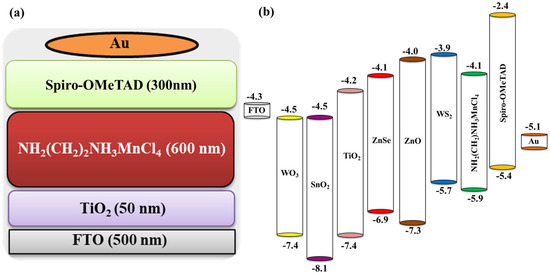
Scheme 1.
Pictorial representation showing device structure (a) and energy level; (b) diagram of PSCs.
3. Results
3.1. Photovoltaic Performance of Simulated PSCs
The photovoltaic performance of the simulated PSCs devices were evaluated by J-V curves. Figure 1 shows the J-V graph of the numerically simulated PSC device (FTO/TiO2 (50 nm)/NH3(CH2)NH3MnCl4 (250 nm)/Spiro-OMeTAD (300 nm)/Au). The simulated device exhibited good Voc (1.47 V) and Jsc (13.02 mA/cm2).
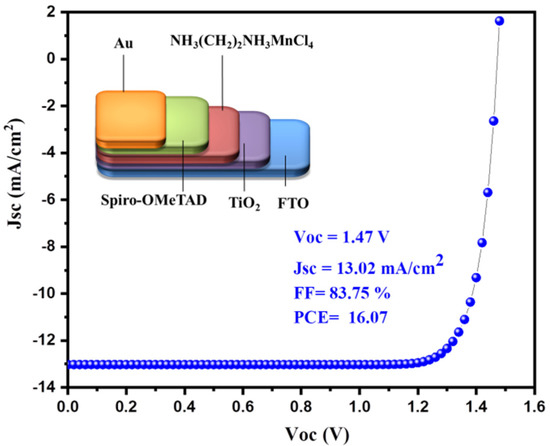
Figure 1.
JV graph of FTO/TiO2 (50 nm)/NH3(CH2)NH3MnCl4 (250 nm)/Spiro-OMeTAD (300 nm)/Au.
This enhanced Voc value indicated better electron transportation between the NH3(CH2)NH3MnCl4 and TiO2 layer, and an interesting PCE of 16.07% was obtained. This obtained PCE showed that NH3(CH2)NH3MnCl4 may be a potential Pb-free light absorber material for the development of PSCs. The thickness of the absorber (NH3(CH2)NH3MnCl4) layer plays an important role, which can significantly affect the photovoltaic activity of the developed PSCs. Therefore, we optimized the thickness of the NH3(CH2)2NH3MnCl4 to examine the effect of thickness on the photovoltaic performance of the simulated device.
We simulated the PSC device (FTO/TiO2 (50 nm)/NH3(CH2)NH3MnCl4(varying)/Spiro-OMeTAD (300 nm)/Au) by varying the thickness (50, 250, 400, 600, 800, and 1000 nm) of the NH3(CH2)2NH3MnCl4 layer. Figure 2A demonstrates the J-V graphs of the PSCs with various thicknesses of NH3(CH2)NH3MnCl4. The simulated results showed that the Voc and FF of the PSCs decrease, whereas the Jsc value increases with increasing thicknesses of NH3(CH2)2NH3MnCl4 from 50 nm to 1000 nm. However, the PCE is enhanced when the thickness of the NH3(CH2)2NH3MnCl4 layer increases (Figure 2B).
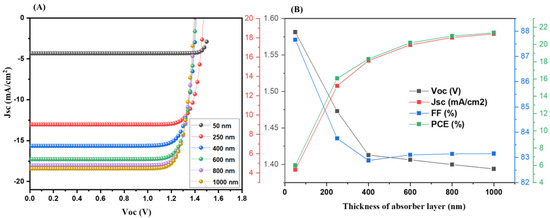
Figure 2.
J-V curves (A) and photovoltaic parameters (B) of FTO/TiO2 (50 nm)/NH3(CH2)NH3MnCl4(varying)/Spiro-OMeTAD (300 nm)/Au.
The high thickness of the NH3(CH2)2NH3MnCl4 layer had a more active absorber area, which resulted in the creation of more photons and increased Jsc value (Figure 2B). On the other side, a high thickness of the NH3(CH2)2NH3MnCl4 layer may allow higher carrier recombination, which may be responsible for decreased Voc value. Therefore, it is required to use the optimum thickness of the NH3(CH2)2NH3MnCl4 layer to overcome the issue of carrier recombination without compromising the PCE of the device. The observations showed that the PCE increases rapidly with the increasing thickness of the NH3(CH2)2NH3MnCl4 layer up to 600 nm thickness. Therefore, we used a 600 nm thickness of the NH3(CH2)2NH3MnCl4 layer for further simulation studies. The thickness of ETL and/or HTL plays an important role in PSCs. Hence, we optimized the thickness of TiO2 and spiro-OMeTAD layers.
Figure 3A showed the J-V graphs of the FTO (500 nm)/TiO2(varying)/NH3(CH2)2NH3MnCl4 (600 nm)/spiro-OMeTAD (300 nm) devices. The obtained results indicated that the Voc, Jsc, and PCE of the PSCs devices decrease when the thickness of the TiO2 layer changes from 50 nm to 250 nm (Figure 3B). It is well-known that sheet resistance increases while conductivity decreases with the increasing thickness of ETL. Therefore, the optimum thickness of the TiO2 layer was found to be 50 nm for further investigations. The optimization of HTL is very important because of the direct contact between HTL and the counter electrode (Au). If the thickness of HTL is very thin, then the counter electrode may contact the light absorber layer. If the thickness of HTL is very thick, then it may increase sheet resistance and reduce the performance of the photovoltaic device. Thus, optimization of the thickness of HTL is of great importance to achieve the high efficiency of PSCs. Figure 4A showed the J-V curves of the FTO/TiO2 (50 nm)/NH3(CH2)NH3MnCl4 (600 nm)/Spiro-OMeTAD(varying)/Au with different thicknesses of spiro-OMeTAD.
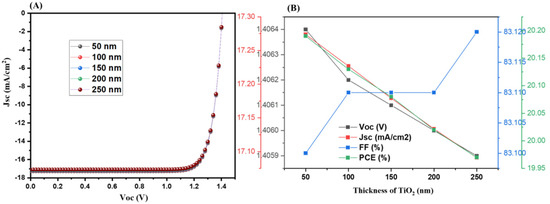
Figure 3.
J-V curves (A) and photovoltaic parameters (B) of FTO/TiO2(varying)/NH3(CH2)NH3MnCl4 (600 nm)/Spiro-OMeTAD (300 nm)/Au.
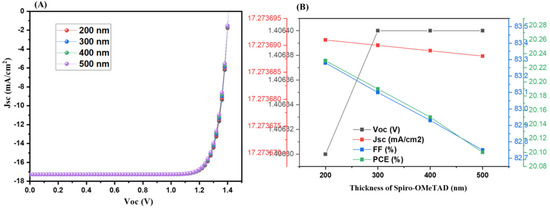
Figure 4.
J-V curves (A) and photovoltaic parameters (B) of FTO/TiO2 (50 nm)/NH3(CH2)NH3MnCl4 (600 nm)/Spiro-OMeTAD(varying)/Au.
The simulation results (J-V graphs) showed that Voc increases whereas Jsc and PCE decrease when the thickness of the spiro-OMeTAD changes from 200 nm to 500 nm (Figure 4B). The increasing thickness of spiro-OMeTAD may increase sheet resistance which reduces the PCE of the PSCs. Thus, it is important to find out the optimum thickness of spiro-OMeTAD. The optimum thickness of 300 nm of spiro-OMeTAD was used for further photovoltaic investigations. The optimization efficiency with respect to the thickness of the absorber layer, ETL, and HTL are provided in Tables S3–S6 in the supporting material.
The type of ETL has a great impact on the performance of the PSCs. Thus, the selection of suitable ETLs is necessary to develop high-performance PSCs. Therefore, we have employed tin oxide (SnO2), zinc oxide (ZnO), tungsten trioxide (WO3), tungsten disulfide (WS2), and zinc selenide (ZnSe) as the ETL for the simulation of high-performance PSCs. Figure 5B shows the J-V curve of the simulated PSCs with SnO2, such as ETL, which exhibited a PCE of 20.28%. This PCE was higher than that of the TiO2-based PSCs device (Figure 5A). In the case of WS2, PCE was decreased to 19.89% (Figure 5C), whereas ZnSe-based PSCs exhibited an improved PCE of 20.30% (Figure 5D). The photovoltaic performance of optimized PSCs with different ETLs have been summarized in Table S7. The WO3-based PSC device exhibited a PCE of 20.20% (Figure 5E), whereas ZnO-based PSCs showed a PCE of 20.23% (Figure 5F). The SnO2-based device exhibited a good PCE of 20.28%, but an improved PCE of 20.30% was obtained for ZnSe-based PSCs. Thus, it can be stated that ZnSe may be the most suitable and efficient ETL for the development of high-performance Pb-free PSCs. The highest PCE for ZnSe-based PSCs may be due to the high electron/hole mobility and better charge extraction/electron transportation. Moreover, the conduction band of ZnSe is in better alignment with the lowest unoccupied molecular orbital (LUMO) of NH3(CH2)NH3MnCl4. This well-matching of energy level values and high electron-hole mobility of ZnSe facilitates electron transfer and results in the enhanced photovoltaic performance of the PSCs. The external quantum efficiency (EQE) of the best-performing devices with different ETLs was also investigated. The EQE graphs of the PSCs with different ETLs have been presented in Figure S1. The obtained results showed that EQE covers the maximum visible region up to 700 nm.
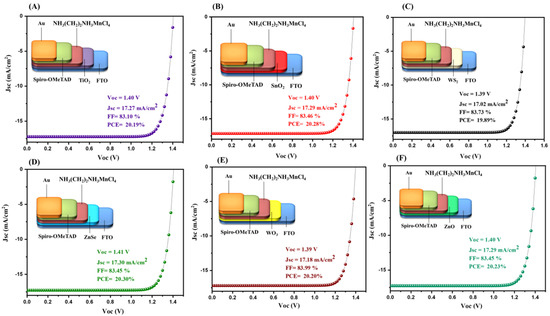
Figure 5.
J-V curves (A–F) of FTO/ETL (50 nm)/NH3(CH2)NH3MnCl4 (600 nm)/Spiro-OMeTAD (300 nm)/Au.
To verify our used calculations and software inputs, we also simulated PSCs (TiO2/MASnI3/spiro-OMeTAD) according to what was reported elsewhere [29]. The J-V graph of the simulated PSCs device has been presented in Figure 6. The obtained results showed the Voc of 0.92 f V with an FF of 67.51%. The simulated PSC (TiO2/MASnI3/spiro-OMeTAD) device also exhibits a Jsc and PCE of 26.83 mA/cm2 and 16.72%, respectively. Singh et al. [29] reported PSC devices with photovoltaic parameters of Jsc, FF (%), Voc, and PCE of 26.90 mA/cm2, 67.19, 0.924 V, and 16.71%, respectively. Our obtained results are almost identical to the previously reported PSC (TiO2/MASnI3/spiro-OMeTAD) device [29]. This suggested that our simulated results for NH3(CH2)NH3MnCl4-based PSCs are authentic.
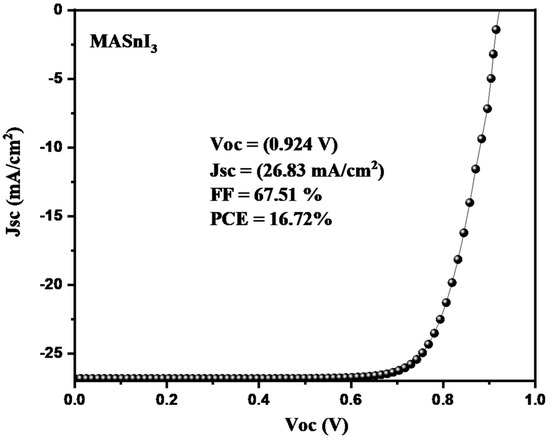
Figure 6.
J-V graph of reference device (TiO2/MASnI3/spiro-OMeTAD) [29].
Recently, various research groups have adopted SCAP-1D for numerical simulation studies of PSCs. In this connection, Hima et al. [3] optimized the performance of CH3NH3GeI3-based PSCs and reported an interesting PCE of 13.30%. Raoui et al. [33] employed a double halide perovskite Cs2AgBiBr6 light absorber and reported a PCE of 5.15%, whereas 7.36% was achieved using FACsPb0.5Sn0.5I3. Sharma et al. [34] employed a Cs2AgBi0.75Sb0.25Br6 light absorber and reported a decent PCE of 10.01%. Ahmad et al. [35] reported a PCE of 15.06% using Cs2TiI6, whereas Ahmed et al. [36] obtained a PCE of 11.49% using a Cs2TiBr6 light absorber. In another work, Cs2TiBr6 was also employed as a light absorber, and the reported PCE was 8.51% [37]. Lee et al. [38] utilized CsSnBr3 and reported a PCE of 10.46% whereas 9.66% efficiency was reported for CsSnCl3-based PSCs [39]. In our case, we have achieved a higher PCE of 20.30%, which is comparable with recent works, as listed in Table 1. Therefore, it can be said that NH3(CH2)2NH3MnCl4 may be a potential absorber layer for the development of high-performance Pb-free PSCs.

Table 1.
Comparison of performance of simulated NH3(CH2)2NH3MnCl4-based PSCs with recently published simulated work [3,33,34,36,37,38,39].
3.2. Photovoltaic Properties of Fabricated PSCs
To further validate the simulated results, we have fabricated PSCs using NH3(CH2)2NH3MnCl4 as a light absorber layer, whereas TiO2 and spiro-OMeTAD were ETL and HTL, respectively. Firstly, we prepared a thin film of NH3(CH2)2NH3MnCl4 on FTO glass substrates by spin coating, and its physiochemical and optical properties were investigated. The recorded X-ray diffraction (XRD) pattern of the NH3(CH2)2NH3MnCl4 is presented in Figure 7a. The XRD pattern of NH3(CH2)2NH3MnCl4 showed a strong diffraction peak at ~9.6°, which indicated the presence of a crystalline nature. The obtained XRD pattern was well-matched with CCDC number 2015666. The surface morphology of the prepared NH3(CH2)2NH3MnCl4 film was also examined by employing scanning electron microscopy (SEM) analysis. The obtained SEM image of the NH3(CH2)2NH3MnCl4 film is presented in Figure 7b. The observations suggest that NH3(CH2)2NH3MnCl4 has a rough surface, which may be due to the rapid crystallization of NH3(CH2)2NH3MnCl4. The optical property of the NH3(CH2)2NH3MnCl4 was studied by using ultraviolet-visible (UV-vis)-absorption spectroscopy. The collected UV-vis spectrum of the NH3(CH2)2NH3MnCl4 is depicted in Figure 7c. The obtained results for NH3(CH2)2NH3MnCl4 exhibit an absorption band at the wavelength of 600–700 nm. The optical bandgap of the NH3(CH2)2NH3MnCl4 was determined by using the Tauc relation. The Tauc-plot of the NH3(CH2)2NH3MnCl4 is depicted in the inset of Figure 7c, which shows that NH3(CH2)2NH3MnCl4 has a band gap of ~1.81 eV. This obtained band gap is suitable for photovoltaic applications. Furthermore, we fabricated a PSC device (FTO/c-TiO2/m-TiO2/NH3(CH2)2NH3MnCl4/Spiro-OMeTAD/Au) under a controlled humidity (~30–40%). Further, the photovoltaic performance of the developed PSC device was evaluated by collecting a J-V graph under 1 sun conditions. The obtained J-V graph of the FTO/c-TiO2/m-TiO2/NH3(CH2)2NH3MnCl4/Spiro-OMeTAD/Au is presented in Figure 7d. The obtained results (J-V graph) showed a good Voc value of 510 mV but a lower Jsc of 0.71 mA/cm2 along with an FF value of 32%. Therefore, the obtained PCE was found to be 0.12%. This experimental PCE was poor compared to the theoretical findings, but we believe this poor performance of the fabricated device may be further enhanced by employing novel device architectures and controlling the rapid crystallization of NH3(CH2)2NH3MnCl4. The EQE of the fabricated PSC device was also collected. The obtained EQE of the NH3(CH2)2NH3MnCl4-based PSCs is depicted in Figure S2, which shows the light absorption between the wavelength of 300 and 600 nm.
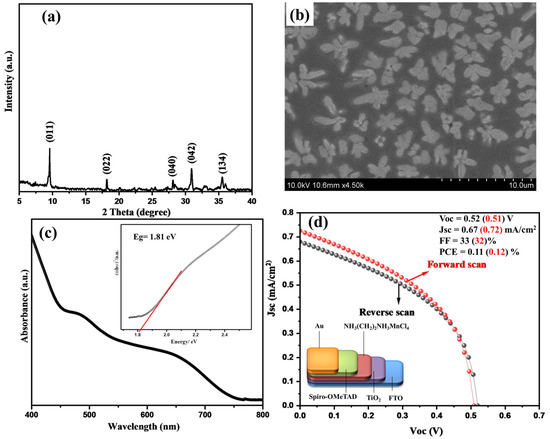
Figure 7.
XRD (a), SEM (b), and UV-vis spectrum (c) of NH3(CH2)2NH3MnCl4 (Inset shows Tauc plot). J-V curve (d) of fabricated PSCs.
Previously, many research groups have developed Pb-free PSCs using different light absorbers. In 2015, Park et al. [40] developed PSCs using mixed halide (CH3NH3)3Bi2I9Clx perovskite-like material and reported a PCE of 0.003%. Cortecchia et al. [41] used a copper-based perovskite light absorber ((CH3NH3)2CuCl2Br2) and reported that the PCE was 0.017%. In another report, 1,6-hexanediammonium bismuth iodide was employed as the absorber material by Fabian et al. [42], and the obtained PCE was 0.027%. Ahmad et al. [23] reported a PCE of 0.1% using (CH3NH3)3Sb2I9, whereas 0.001% was obtained using [(CH3NH3)3Bi2Cl9]n as a light absorber [26]. Thind et al. [43] utilized a KBaTeBiO6 light absorber and fabricated a PSC device that showed a PCE of 0.06%. Mixed halide (NH4)3Sb2I3Br6 was used by Zuo et al. [44], and the developed device exhibited a poor PCE of 0.06%. In some other reports, bismuth-based absorber layers have also been used for the construction of Pb-free PSCs. In this report, we demonstrated the role of NH3(CH2)2NH3MnCl4 as an absorber layer, which exhibited decent photovoltaic performance, as listed in Table 2. It can be clearly seen from Table 2 that the PCE of NH3(CH2)2NH3MnCl-based fabricated PSC device is poor (0.12%) but showed a decent Voc. The absorber layer should have a low band gap for better light absorption. Although NH3(CH2)2NH3MnCl4 has a good optical band gap, we believe that the poor PCE and Jsc of the NH3(CH2)2NH3MnCl4-based fabricated PSC device may be attributed to the poor morphological characteristics and fast crystallization process. The rapid crystallization of perovskite films has been a major concern in developing high-performance photovoltaic devices. The preparation of pin-hole-free and high-quality thin films with large grain boundaries is of great importance for the construction of highly efficient PSC devices. Previously, two-step deposition methods or anti-solvents such as chlorobenzene have been used for the preparation of high-quality thin films of perovskite materials. Some new preparation methods need to be developed to exert tight control on the crystallization process. It is also important to study the mechanism of thin film formation, charge-separation/recombination at interfaces/grain boundaries to further improve the performance of NH3(CH2)2NH3MnCl4-based PSCs. We believe that, if systematic investigations are implemented, significant improvements in the performance of the NH3(CH2)2NH3MnCl4-based PSCs can be seen in the near future.

Table 2.
Comparison of Voc, Jsc, FF, and PCE of the fabricated NH3(CH2)2NH3MnCl4-based PSCs with recently published experimental works [23,26,40,41,42,43,44,45,46,47,48,49].
4. Conclusions
Finally, it can be summarized that highly efficient Pb-free PSCs have been simulated via SCAPS-1D. Further, we optimized the thickness of electron, absorber, and hole transport material layers. The numerically simulated PSCs exhibited good efficiency of 20.30% via SCAPS-1D. Various electron transport layers (WS2, ZnO, SnO2, TiO2, ZnSe, and WO3) were employed, and ZnSe-based PSCs showed the highest efficiency, which may be due to the high electron-hole mobility and suitable energy level values of ZnSe. Furthermore, NH3(CH2)2NH3MnCl4 was prepared, and its optical band gap was found to be 1.81 eV, which is suitable for a light absorber layer. Further, PSCs were fabricated, and the developed device exhibited a good Voc of 510 mV with a poor PCE of 0.12%. We believe this PCE may be further enhanced in the future by using/introducing some new device architectures or fabrication methods.
Supplementary Materials
The following supporting information can be downloaded at: https://www.mdpi.com/article/10.3390/nano12193407/s1, Figure S1: QE curves (a–f) of FTO/ETL(50 nm)/NH3(CH2)NH3MnCl4(600 nm)/Spiro-OMeTAD(300 nm)/A; Figure S2: EQE curve of the fabricated PSCs deviceTable S1. Numerical parameters of different materials for device simulation; Table S2: Numerical parameters of different ETLs for device simulation; Table S3: Effect of thickness of light absorber layer; Table S4: Effect of thickness of TiO2; Table S5: Effect of thickness of Spiro-OMeTAD; Table S6: Effect of different ETL layers.
Author Contributions
Conceptualization, K.A. and W.R.; Methodology, R.A.K. and W.R.; Formal analysis, R.A.K. and W.R.; Writing—original draft. W.R., A.A. and K.A.; Writing–review & editing, H.K. and A.A.; Supervision, H.K. and A.A. Funding acquisition, H.K. and A.A. All authors have read and agreed to the published version of the manuscript.
Funding
This work was supported by the Korea Innovation Foundation (INNOPOLIS) [grant number 2020-DD-UP-0278], the National Research Foundation of Korea (NRF) grant funded by the Korea government (MSIT; NRF-2022R1A2C1005585) and Researchers Supporting Project (Project number, RSP-2021/78), King Saud University (Riyadh, Saudi Arabia).
Institutional Review Board Statement
Not applicable.
Informed Consent Statement
Not applicable.
Data Availability Statement
Not applicable.
Acknowledgments
A. Alsalme would like to acknowledge the Researchers Supporting Project (Project number, RSP-2021/78), King Saud University (Riyadh, Saudi Arabia). Authors would like to express thanks to Marc Burgelman for SCAPS-1D.
Conflicts of Interest
The authors declare no conflict of interest.
References
- Kabir, E.; Kumar, P.; Kumar, S.; Adelodun, A.A.; Kim, K.-H. Solar energy: Potential and future prospects. Renew. Sustain. Energy Rev. 2018, 82, 894–900. [Google Scholar] [CrossRef]
- Gong, J.; Li, C.; Wasielewski, M.R. Advances in solar energy conversion. Chem. Soc. Rev. 2019, 48, 1862–1864. [Google Scholar] [CrossRef] [PubMed]
- Lakhdar, N.; Hima, A. Electron transport material effect on performance of perovskite solar cells based on CH3NH3GeI3. Opt. Mater. 2020, 99, 109517. [Google Scholar] [CrossRef]
- Jeong, J.; Kim, M.; Seo, J.; Lu, H.; Ahlawat, P.; Mishra, A.; Yang, Y.; Hope, M.A.; Eickemeyer, F.T.; Kim, M.; et al. Pseudo-halide anion engineering for α-FAPbI3 perovskite solar cells. Nature 2021, 592, 381–385. [Google Scholar] [CrossRef] [PubMed]
- Kojima, A.; Teshima, K.; Shirai, Y.; Miyasaka, T. Organometal Halide Perovskites as Visible-Light Sensitizers for Photovoltaic Cells. J. Am. Chem. Soc. 2009, 131, 6050–6051. [Google Scholar] [CrossRef] [PubMed]
- Grätzel, M. The light and shade of perovskite solar cells. Nat. Mater. 2014, 13, 838–842. [Google Scholar] [CrossRef]
- Park, N.-G.; Grätzel, M.; Miyasaka, T.; Zhu, K.; Emery, K. Towards stable and commercially available perovskite solar cells. Nat. Energy 2016, 1, 16152. [Google Scholar] [CrossRef]
- Correa-Baena, J.-P.; Saliba, M.; Buonassisi, T.; Grätzel, M.; Abate, A.; Tress, W.; Hagfeldt, A. Promises and challenges of perovskite solar cells. Science 2017, 358, 739–744. [Google Scholar] [CrossRef]
- Liu, Z.; Qiu, L.; Ono, L.K.; He, S.; Hu, Z.; Jiang, M.; Tong, G.; Wu, Z.; Jiang, Y.; Son, D.-Y.; et al. A holistic approach to interface stabilization for efficient perovskite solar modules with over 2000-hour operational stability. Nat. Energy 2020, 5, 596–604. [Google Scholar] [CrossRef]
- Ahmad, K.; Mobin, S.M. Graphene oxide based planar heterojunction perovskite solar cell under ambient condition. New J. Chem. 2017, 41, 14253–14258. [Google Scholar] [CrossRef]
- Saliba, M.; Matsui, T.; Seo, J.-Y.; Domanski, K.; Correa-Baena, J.-P.; Nazeeruddin, M.K.; Zakeeruddin, S.M.; Tress, W.; Abate, A.; Hagfeldt, A.; et al. Cesium-containing triple cation perovskite solar cells: Improved stability, reproducibility and high efficiency. Energy Environ. Sci. 2016, 9, 1989–1997. [Google Scholar] [CrossRef] [PubMed]
- Min, H.; Kim, M.; Lee, S.-U.; Kim, H.; Kim, G.; Choi, K.; Lee, J.H.; Seok, S.I. Efficient, stable solar cells by using inherent bandgap of α-phase formamidinium lead iodide. Science 2019, 366, 749–753. [Google Scholar] [CrossRef] [PubMed]
- Yang, S.; Liu, W.; Zuo, L.; Zhang, X.; Ye, T.; Chen, J.; Li, C.-Z.; Wu, G.; Chen, H. Thiocyanate assisted performance enhancement of formamidinium based planar perovskite solar cells through a single one-step solution process. J. Mater. Chem. A 2016, 4, 9430–9436. [Google Scholar] [CrossRef]
- Kim, D.H.; Muzzillo, C.P.; Tong, J.; Palmstrom, A.F.; Larson, B.W.; Choi, C.; Harvey, S.P.; Glynn, S.; Whitaker, J.B.; Zhang, F.; et al. Bimolecular Additives Improve Wide-Band-Gap Perovskites for Efficient Tandem Solar Cells with CIGS. Joule 2019, 3, 1734–1745. [Google Scholar] [CrossRef]
- Kumar, P.; Ahmad, K.; Dagar, J.; Unger, E.; Mobin, S.M. Two-Step Deposition Approach for Lead Free (NH4)3Sb2I9 Perovskite Solar Cells with Enhanced Open Circuit Voltage and Performance. ChemElectroChem 2021, 8, 3150–3154. [Google Scholar] [CrossRef]
- Noel, N.K.; Stranks, S.D.; Abate, A.; Wehrenfennig, C.; Guarnera, S.; Haghighirad, A.-A.; Sadhanala, A.; Eperon, G.E.; Pathak, S.K.; Johnston, M.B.; et al. Lead-free organic–inorganic tin halide perovskites for photovoltaic applications. Energy Environ. Sci. 2014, 7, 3061–3068. [Google Scholar] [CrossRef]
- Wang, P.; Li, F.; Jiang, K.-J.; Zhang, Y.; Fan, H.; Zhang, Y.; Miao, Y.; Huang, J.-H.; Gao, C.; Zhou, X.; et al. Ion Exchange/Insertion Reactions for Fabrication of Efficient Methylammonium Tin Iodide Perovskite Solar Cells. Adv. Sci. 2020, 7, 1903047. [Google Scholar] [CrossRef]
- Kumar, M.H.; Dharani, S.; Leong, W.L.; Boix, P.P.; Prabhakar, R.R.; Baikie, T.; Shi, C.; Ding, H.; Ramesh, R.; Asta, M.; et al. Lead-Free Halide Perovskite Solar Cells with High Photocurrents Realized Through Vacancy Modulation. Adv. Mater. 2014, 26, 7122–7127. [Google Scholar] [CrossRef]
- Joshi, P.H.; Zhang, L.; Hossain, I.M.; Abbas, H.A.; Kottokkaran, R.; Nehra, S.P.; Dhaka, M.; Noack, M.; Dalal, V.L. The Physics of Photon induced Degradation of Perovskite Solar Cells. AIP Adv. 2016, 6, 115114. [Google Scholar] [CrossRef]
- Zhang, J.; Wang, L.; Jiang, C.; Cheng, B.; Chen, T.; Yu, J. CsPbBr3 Nanocrystal Induced Bilateral Interface Modification for Efficient Planar Perovskite Solar Cells. Adv. Sci. 2021, 8, 2102648. [Google Scholar] [CrossRef]
- Singh, N.; Agarwal, A.; Agarwal, M. Performance evaluation of lead–free double-perovskite solar cell. Opt. Mater. 2021, 114, 110964. [Google Scholar] [CrossRef]
- Ahmad, K.; Kumar, P.; Mobin, S.M. Inorganic Pb-Free Perovskite Light Absorbers for Efficient Perovskite Solar Cells with Enhanced Performance. Chem. Asian J. 2020, 15, 2859–2863. [Google Scholar] [CrossRef] [PubMed]
- Ahmad, K.; Kumar, P.; Mobin, S.M. A Two-Step Modified Sequential Deposition Method-based Pb-Free (CH3NH3)3Sb2I9 Perovskite with Improved Open Circuit Voltage and Performance. ChemElectroChem 2020, 7, 946–950. [Google Scholar] [CrossRef]
- Ahmad, K.; Mobin, S.M. Organic–Inorganic Copper (II)-Based Perovskites: A Benign Approach toward Low-Toxicity and Water-Stable Light Absorbers for Photovoltaic Applications. Energy Technol. 2020, 8, 1901185. [Google Scholar] [CrossRef]
- Ahmad, K.; Ansari, S.N.; Natarajan, K.; Mobin, S.M. A (CH3NH3)3Bi2I9 Perovskite Based on a Two-Step Deposition Method: Lead-Free, Highly Stable, and with Enhanced Photovoltaic Performance. ChemElectroChem 2019, 6, 1192–1198. [Google Scholar] [CrossRef]
- Ahmad, K.; Ansari, S.N.; Natarajan, K.; Mobin, S.M. Design and Synthesis of 1D-Polymeric Chain Based [(CH3NH3)3Bi2Cl9]n Perovskite: A New Light Absorber Material for Lead Free Perovskite Solar Cells. ACS Appl. Energy Mater. 2018, 1, 2405–2409. [Google Scholar] [CrossRef]
- Tahiri, O.; Kassou, S.; Ettakni, M.; Belaaraj, A. Simulation studies of lead-free Mn-based 2D perovskite solar cells. Semicond. Sci. Technol. 2021, 36, 095043. [Google Scholar] [CrossRef]
- Burgelman, M.; Nollet, P.; Degrave, S. Modelling polycrystalline semiconductor solar cells. Thin Solid Films 2000, 361–362, 527–532. [Google Scholar] [CrossRef]
- Singh, A.K.; Srivastava, S.; Mahapatra, A.; Baral, J.K.; Pradhan, B. Performance optimization of lead free-MASnI3 based solar cell with 27% efficiency by numerical simulation. Opt. Mater. 2021, 117, 111193. [Google Scholar] [CrossRef]
- Rahman, M.A. Design and simulation of a high-performance Cd-free Cu2SnSe3 solar cells with SnS electron-blocking hole transport layer and TiO2 electron transport layer by SCAPS-1D. SN Appl. Sci. 2021, 3, 253. [Google Scholar] [CrossRef]
- Otoufi, M.K.; Ranjbar, M.; Kermanpur, A.; Taghavinia, N.; Minbashi, M.; Forouzandeh, M.; Ebadi, F. Enhanced performance of planar perovskite solar cells using TiO2/SnO2 and TiO2/WO3 bilayer structures: Roles of the interfacial layers. Sol. Energ. 2020, 208, 697–707. [Google Scholar] [CrossRef]
- Raoui, Y.; Ez-Zahraouy, H.; Ahmad, S.; Kazim, S. Unravelling the theoretical window to fabricate high performance inorganic perovskite solar cells. Sustain. Energy Fuels 2021, 5, 219–229. [Google Scholar] [CrossRef]
- Alam, I.; Mollick, R.; Ashraf, M.A. Numerical simulation of Cs2AgBiBr6-based perovskite solar cell with ZnO nanorod and P3HT as the charge transport layers. Physica B Condensed Mat. 2021, 618, 413187. [Google Scholar] [CrossRef]
- Madan, J.; Shivani; Pandey, R.; Sharma, R. Device simulation of 17.3% efficient lead-free all-perovskite tandem solar cell. Sol. Energy 2020, 197, 212–222. [Google Scholar] [CrossRef]
- Ahmad, O.; Rashid, A.; Ahmed, M.W.; Nasir, M.F.; Qasim, I. Performance evaluation of Au/p-CdTe/Cs2TiI6/n-TiO2/ITO solar cell using SCAPS-1D. Opt. Mater. 2021, 117, 111105. [Google Scholar] [CrossRef]
- Ahmed, S.; Jannat, F.; Khan, M.A.K.; Alim, M.A. Numerical development of eco-friendly Cs2TiBr6 based perovskite solar cell with all-inorganic charge transport materials via SCAPS-1D. Optik 2021, 225, 165765. [Google Scholar] [CrossRef]
- Samanta, M.; Ahmed, S.I.; Chattopadhyay, K.K.; Bose, C. Role of various transport layer and electrode materials in enhancing performance of stable environment-friendly Cs2TiBr6 solar cell. Optik 2020, 217, 164805. [Google Scholar] [CrossRef]
- Chen, L.J.; Lee, C.R.; Chuang, Y.J.; Wu, Z.H.; Chen, C. Synthesis and Optical Properties of Lead Free Cesium Tin Halide Perovskite Quantum Rods with High-Performance Solar Cell Application. J. Phys. Chem. Lett. 2016, 7, 5028–5035. [Google Scholar] [CrossRef]
- Rai, S.; Pandey, B.K.; Garg, A.; Dwivedi, D.K. Hole transporting layer optimization for an efficient lead-free double perovskite solar cell by numerical simulation. Opt. Mater. 2021, 121, 111645. [Google Scholar] [CrossRef]
- Park, B.-W.; Philippe, B.; Zhang, X.; Boschloo, G.; Johansson, E.M.J. Bismuth Based Hybrid Perovskites A3Bi2I9 (A: Methylammonium or Cesium) for Solar Cell Application. Adv. Mater. 2015, 27, 6806–6813. [Google Scholar] [CrossRef]
- Cortecchia, D.; Dewi, H.A.; Yin, J.; Bruno, A.; Chen, S.; Baikie, T.; Boix, P.P.; Gratzel, M.; Mhaisalkar, S.; Soci, C.; et al. Lead-Free MA2CuClxBr4−x Hybrid Perovskites. Inorg. Chem. 2016, 55, 1044–1052. [Google Scholar] [CrossRef] [PubMed]
- Fabian, D.M.; Ardo, S. Hybrid organic–inorganic solar cells based on bismuth iodide and 1,6-hexanediammonium dication. J. Mater. Chem. A 2016, 4, 6837–6841. [Google Scholar] [CrossRef]
- Thind, A.S.; Kavadiya, S.; Kouhnavard, M.; Wheelus, R.; Cho, S.B.; Lin, L.Y.; Kacica, C.; Mulmudi, H.K.; Unocic, K.A.; Borisevich, A.Y.; et al. KBaTeBiO6: A Lead-Free, Inorganic Double-Perovskite Semiconductor for Photovoltaic Applications. Chem. Mater. 2019, 31, 4769–4778. [Google Scholar] [CrossRef]
- Zuo, C.; Ding, L. Lead-free Perovskite Materials (NH4)3Sb2IxBr9-x. Angew. Chem. Int. Ed. 2017, 56, 6528. [Google Scholar] [CrossRef]
- Khadka, D.B.; Shirai, Y.; Yanagida, M.; Miyano, K. Tailoring the film morphology and interface band offset of caesium bismuth iodide-based Pb-free perovskite solar cells. J. Mater. Chem. C 2019, 7, 8335–8343. [Google Scholar] [CrossRef]
- Kang, J.; Chen, S.; Hao, M.; Liu, J.; Al-mamun, M.; Liu, P.; Wang, Y.; Yin, H.; Zhao, H. Alloying Sb into all inorganic lead-free CsBi3I10 for improving the crystal growth and photovoltaic performance. J. Mater. Chem. A 2022, 10, 19618–19625. [Google Scholar] [CrossRef]
- Kulkarni, A.; Jena, A.K.; Ikegami, M.; Miyasaka, T. Performance enhancement of AgBi2I7 solar cells by modulating a solvent-mediated adduct and tuning remnant BiI3 in one-step crystallization. Chem. Commun. 2019, 55, 4031–4034. [Google Scholar] [CrossRef]
- Pandian, M.G.M.; Khadka, D.B.; Shirai, Y.; Umedov, S.; Yanagida, M.; Subashchandran, S.; Grigorieva, A.; Miyano, K. Effect of solvent vapour annealing on bismuth triiodide film for photovoltaic applications and its optoelectronic properties. J. Mater. Chem. C 2020, 8, 12173–12180. [Google Scholar] [CrossRef]
- Kulkarni, A.; Singh, T.; Jena, A.K.; Pinpithak, P.; Ikegami, M.; Miyasaka, T. Vapor Annealing Controlled Crystal Growth and Photovoltaic Performance of Bismuth Triiodide Embedded in Mesostructured Configurations. ACS Appl. Mater. Interfaces 2018, 10, 9547–9554. [Google Scholar] [CrossRef]
Publisher’s Note: MDPI stays neutral with regard to jurisdictional claims in published maps and institutional affiliations. |
© 2022 by the authors. Licensee MDPI, Basel, Switzerland. This article is an open access article distributed under the terms and conditions of the Creative Commons Attribution (CC BY) license (https://creativecommons.org/licenses/by/4.0/).